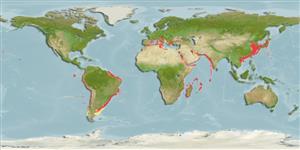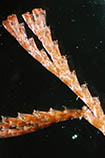Bugula neritina (Linnaeus, 1758)
Branching moss worm| Native range | All suitable habitat | Point map | Year 2050 |

|
| This map was computer-generated and has not yet been reviewed. |
| Bugula neritina AquaMaps Data sources: GBIF OBIS |
Classification / Names Common names | Synonyms | CoL | ITIS | WoRMS
Gymnolaemata | Cheilostomatida | Bugulidae
Environment: milieu / climate zone / depth range / distribution range Ecology
Sessile; depth range 0 - 320 m (Ref. 865). Temperate
Distribution Countries | FAO areas | Ecosystems | Occurrences | Introductions
Circumglobal in tropical and temperate seas.
Length at first maturity / Size / Weight / Age
Maturity: Lm ? range ? - ? cm Max length : 10.0 cm H male/unsexed; (Ref. 3248)
Maximum depth from Ref. 116066. Epibenthic, encrusting, erect (Ref. 116066). Found in rocky subtidal (Ref. 116251), on giant kelp fronds, pilings, and boats hulls to a depth of 80 meters (Ref. 865). Suspension feeder (Ref. 116251). Part of fouling communities attached to raft frames in mariculture zones (Ref. 127121).
Life cycle and mating behavior Maturity | Reproduction | Spawning | Eggs | Fecundity | Larvae
Members of the phylum Bryozoa are hermaphroditic. Both fertilization and egg brooding may either be internal or external.
Main reference
References | Coordinator | Collaborators
Gappa, J.L. 2000. (Ref. 1202)
IUCN Red List Status (Ref. 130435)
CITES status (Ref. 108899)
Not Evaluated
CMS (Ref. 116361)
Not Evaluated
Threat to humans
Human uses
| FishSource |
Tools
More information
Age/Size
Growth
Length-weight
Length-length
Morphology
Larvae
Abundance
Growth
Length-weight
Length-length
Morphology
Larvae
Abundance
Internet sources
BHL | BOLD Systems | CISTI | DiscoverLife | FAO(Publication : search) | Fishipedia | GenBank (genome, nucleotide) | GloBI | Gomexsi | Google Books | Google Scholar | Google | PubMed | Tree of Life | Wikipedia (Go, Search) | Zoological Record
Estimates based on models
Preferred temperature
(Ref. 115969): 14.8 - 24.9, mean 19.7 (based on 400 cells).
Price category
(Ref. 80766):
Unknown.



